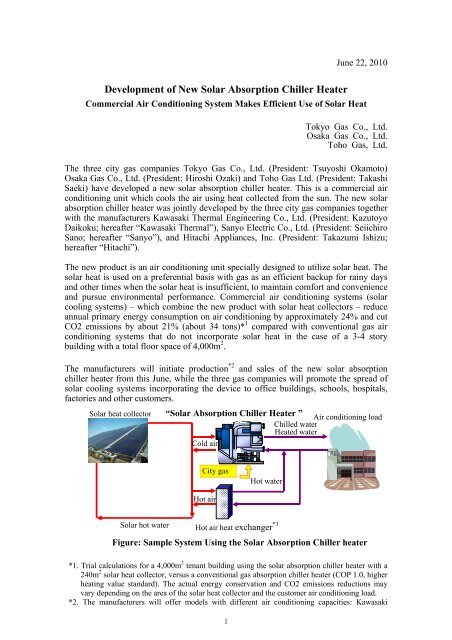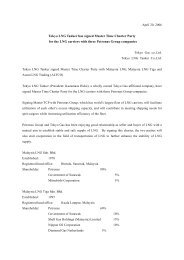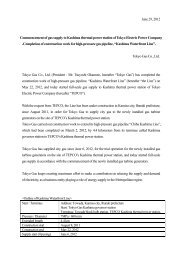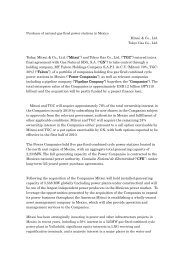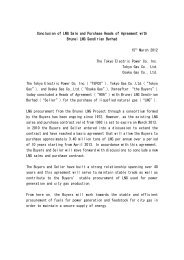2010/06/22 Development of New Solar Absorption Chiller Heater ...
2010/06/22 Development of New Solar Absorption Chiller Heater ...
2010/06/22 Development of New Solar Absorption Chiller Heater ...
Create successful ePaper yourself
Turn your PDF publications into a flip-book with our unique Google optimized e-Paper software.
June <strong>22</strong>, <strong>2010</strong><br />
<strong>Development</strong> <strong>of</strong> <strong>New</strong> <strong>Solar</strong> <strong>Absorption</strong> <strong>Chiller</strong> <strong>Heater</strong><br />
Commercial Air Conditioning System Makes Efficient Use <strong>of</strong> <strong>Solar</strong> Heat<br />
Tokyo Gas Co., Ltd.<br />
Osaka Gas Co., Ltd.<br />
Toho Gas, Ltd.<br />
The three city gas companies Tokyo Gas Co., Ltd. (President: Tsuyoshi Okamoto)<br />
Osaka Gas Co., Ltd. (President: Hiroshi Ozaki) and Toho Gas Ltd. (President: Takashi<br />
Saeki) have developed a new solar absorption chiller heater. This is a commercial air<br />
conditioning unit which cools the air using heat collected from the sun. The new solar<br />
absorption chiller heater was jointly developed by the three city gas companies together<br />
with the manufacturers Kawasaki Thermal Engineering Co., Ltd. (President: Kazutoyo<br />
Daikoku; hereafter “Kawasaki Thermal”), Sanyo Electric Co., Ltd. (President: Seiichiro<br />
Sano; hereafter “Sanyo”), and Hitachi Appliances, Inc. (President: Takazumi Ishizu;<br />
hereafter “Hitachi”).<br />
The new product is an air conditioning unit specially designed to utilize solar heat. The<br />
solar heat is used on a preferential basis with gas as an efficient backup for rainy days<br />
and other times when the solar heat is insufficient, to maintain comfort and convenience<br />
and pursue environmental performance. Commercial air conditioning systems (solar<br />
cooling systems) – which combine the new product with solar heat collectors – reduce<br />
annual primary energy consumption on air conditioning by approximately 24% and cut<br />
CO2 emissions by about 21% (about 34 tons)* 1 compared with conventional gas air<br />
conditioning systems that do not incorporate solar heat in the case <strong>of</strong> a 3-4 story<br />
building with a total floor space <strong>of</strong> 4,000m 2 .<br />
The manufacturers will initiate production *2 and sales <strong>of</strong> the new solar absorption<br />
chiller heater from this June, while the three gas companies will promote the spread <strong>of</strong><br />
solar cooling systems incorporating the device to <strong>of</strong>fice buildings, schools, hospitals,<br />
factories and other customers.<br />
<strong>Solar</strong> heat collector<br />
“<strong>Solar</strong> <strong>Absorption</strong> <strong>Chiller</strong> <strong>Heater</strong> ” Air conditioning load<br />
Chilled water<br />
Heated water<br />
Cold air<br />
City gas<br />
Hot water<br />
Hot air<br />
<strong>Solar</strong> hot water<br />
Hot air heat exchanger *3<br />
Figure: Sample System Using the <strong>Solar</strong> <strong>Absorption</strong> <strong>Chiller</strong> heater<br />
*1. Trial calculations for a 4,000m 2 tenant building using the solar absorption chiller heater with a<br />
240m 2 solar heat collector, versus a conventional gas absorption chiller heater (COP 1.0, higher<br />
heating value standard). The actual energy conservation and CO2 emissions reductions may<br />
vary depending on the area <strong>of</strong> the solar heat collector and the customer air conditioning load.<br />
*2. The manufacturers will <strong>of</strong>fer models with different air conditioning capacities: Kawasaki<br />
1
Thermal will initiate sales <strong>of</strong> 8 models, Sanyo 4 models and Hitachi 17 models.<br />
*3. During air heating, the solar heat passes through the hot air heat exchanger and produces hot<br />
water.<br />
【DETAILED EXPLANATION】<br />
1. Main Product Characteristics<br />
(1) Maximizes the Use <strong>of</strong> <strong>Solar</strong> Heat<br />
The product allows the use <strong>of</strong> solar heat at the lowest possible temperatures through<br />
such innovations as adding a new solar heat condenser *4 and optimizing the coolant<br />
path. *5,*6 The unit can effectively utilize solar heat at 75ºC at an air conditioning load <strong>of</strong><br />
100%, and make use <strong>of</strong> even lower temperatures at lower loads. For example, the unit<br />
can utilize solar heat as low as around 60ºC at a load <strong>of</strong> 30%. *7<br />
(2) Maximizes System Efficiency<br />
Minimizing the temperatures <strong>of</strong> the hot water removed from the heat collectors and<br />
controlling the radiation <strong>of</strong> heat into the atmosphere are important keys to increasing the<br />
heat collection efficiency <strong>of</strong> heat collectors. The new solar absorption chiller heater<br />
maximizes overall system efficiency by calculating the required temperature ranges for<br />
the use <strong>of</strong> solar heat in accordance with the varying air conditioning load, and keeping<br />
the temperature <strong>of</strong> the hot water removed from the heat collectors as low as possible.<br />
(3) Uses <strong>Solar</strong> Heat Whenever Possible<br />
The unit has an internal control for the use <strong>of</strong> solar heat on a preferential basis. This<br />
works to reduce gas consumption volumes and conserve energy.<br />
(4) Stable Air Conditioning Supply Capacity<br />
The product automatically uses the gas backup to fill air conditioning demand on rainy<br />
days with little heat and at other times when solar heat alone is not sufficient to meet the<br />
required demand. This secures the required capacity at all times for the provision <strong>of</strong><br />
stable and comfortable air conditioning.<br />
(5) High Efficiency COP rating <strong>of</strong> 1.3 *8 or better<br />
When operating using gas only, the unit has an air conditioner COP rating <strong>of</strong> 1.3 or<br />
better (equivalent to an electrical air conditioner COP rating <strong>of</strong> 3.5 or better), with<br />
top-level efficiency as a dual use gas absorption chiller heater.<br />
*4. The solar heat condenser is a device which condenses the refrigerant vapor generated by solar<br />
heat.<br />
*5. The coolant flows through an absorber in regular gas absorption chiller heaters, but passes<br />
though the solar heat condenser in this product.<br />
*6. The three manufacturers are adopting different technologies; this release presents a<br />
representative example.<br />
*7. These are representative figures because the actual figures vary somewhat by manufacturer.<br />
The calculations assume a coolant entrance temperature <strong>of</strong> 25ºC under joint use <strong>of</strong> solar heat<br />
and gas.<br />
*8. Higher heating value standard.<br />
2. <strong>Development</strong> Background<br />
Air conditioning (heating and cooling) accounts for approximately one-third <strong>of</strong><br />
commercial use final energy consumption. The three gas companies each conducted<br />
demonstration projects *9 from FY2009 on the development <strong>of</strong> solar cooling systems<br />
which effectively use solar heat, which is a renewable resource, for the cold water<br />
required for air conditioning.<br />
2
<strong>Solar</strong> cooing systems to date have used GENELINKwaste heat gas absorption chiller<br />
heaters, which utilize the waste heat from cogeneration systems (CGS) for the cold<br />
water. However, these GENELINK chiller heaters with their established technologies<br />
are devices designed for the effective use <strong>of</strong> stable CGS high-temperature waste heat, so<br />
they cannot accommodate the preferential use <strong>of</strong> solar heat when solar hot water<br />
temperatures suddenly change from large variations in the heat collector temperatures<br />
due to changes in the weather.* 10 The new solar absorption chiller heater was specially<br />
designed for the effective use <strong>of</strong> low-temperature solar heat to address this problem and<br />
improve the energy conservation effect from solar cooling systems.<br />
The three manufacturers have moved forward with detailed product design and<br />
production based on the results <strong>of</strong> the demonstration research and product specifications<br />
examinations conducted by the three gas companies.<br />
*9. These demonstration projects were conducted by Tokyo Gas at the Nakahara building, by<br />
Osaka Gas at the company’s pipeline technology center, and by Toho Gas at the Tsu branch<br />
<strong>of</strong>fice.<br />
*10. Hot water heated with CGS waste heat maintains a stable temperature <strong>of</strong> 80ºC or higher, but the<br />
temperature <strong>of</strong> solar hot water sometimes falls below 80ºC because <strong>of</strong> fluctuations in sunshine,<br />
so the preferential use <strong>of</strong> solar heat is not possible using GENELINK chiller heaters.<br />
3. Basic Product Specifications<br />
Kawasaki<br />
Sanyo<br />
Hitachi<br />
Thermal<br />
Air conditioning capacity range 281-1,055[kW]<br />
80-300[RT]<br />
352-703[kW]<br />
100-200[RT]<br />
4<strong>22</strong>-3,516[kW]<br />
120-1,000[RT]<br />
Rated coolant entrance temperature 31[ºC] 31[ºC] 31[ºC]<br />
Cold water temperature 15→7[ºC] 15→7[ºC] 15→7[ºC]<br />
Range <strong>of</strong> usable solar hot water<br />
temperatures (at 100% air<br />
75-98[ºC] 75-98[ºC] 75-98[ºC]<br />
conditioning load)<br />
Gas consumption Gas only 2.68[kW/RT] 2.66[kW/RT] 2.57[kW/RT]<br />
volume (at 100% At rated solar 1.66[kW/RT] 2.14[kW/RT] 1.77[kW/RT]<br />
air conditioning hot water<br />
load)<br />
(@90 ºC)<br />
(@81 ºC)<br />
(@90 ºC)<br />
entrance<br />
temperature<br />
Below rated<br />
solar hot<br />
water<br />
entrance<br />
temperature<br />
2.33[kW/RT]<br />
(@75 ºC)<br />
2.32[kW/RT]<br />
(@75 ºC)<br />
2.44[kW/RT]<br />
(@75 ºC)<br />
3
4. Product Photographs<br />
Kawasaki Thermal Product<br />
Sanyo Product<br />
Hitachi Product<br />
5. <strong>Development</strong> Manufacturer Data<br />
(1) Kawasaki Thermal Engineering Co., Ltd.<br />
• Company Outline<br />
Date established March 10, 1972<br />
Capital<br />
1.4605 billion yen<br />
President<br />
Kazutoyo Daikoku<br />
Business fields Design, manufacturing, installation, servicing, repair, operating<br />
maintenance, sales and rentals <strong>of</strong> general-purpose boilers, air<br />
conditioners, absorption heat pumps and other equipment;<br />
design, execution and supervision <strong>of</strong> civil engineering and<br />
building construction; design, execution and supervision <strong>of</strong><br />
pipeline and electrical construction; other works associated with<br />
the aforementioned businesses.<br />
Head <strong>of</strong>fice location 1000 Aoji-cho, Kusatsu-shi, Shiga Prefecture<br />
(2) Sanyo Electric Co., Ltd.<br />
• Company Outline<br />
Date established April 8, 1950<br />
Capital<br />
3<strong>22</strong>.242 billion yen<br />
President<br />
Seiichiro Sano<br />
Business fields Manufacturing, sales, maintenance and service <strong>of</strong> electric<br />
appliances, air conditioners, commercial equipment,<br />
semiconductors, etc.<br />
Head <strong>of</strong>fice location 2-5-5 Keihan Hondori, Moriguchi-shi, Osaka Prefecture<br />
(3) Hitachi Appliances, Inc.<br />
• Company Outline<br />
Date established April 1, 20<strong>06</strong><br />
Capital<br />
20.0 billion yen<br />
President<br />
Takazumi Ishizu<br />
Business fields <strong>Development</strong>, manufacturing and sales <strong>of</strong> comprehensive air<br />
conditioning and household appliances<br />
Head <strong>of</strong>fice location 2-15-12 Nishishimbashi, Minato-ku, Tokyo<br />
4


